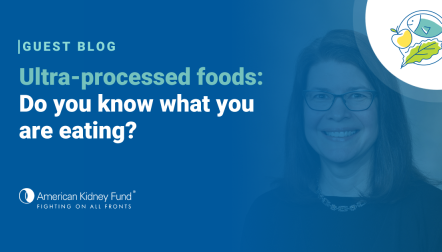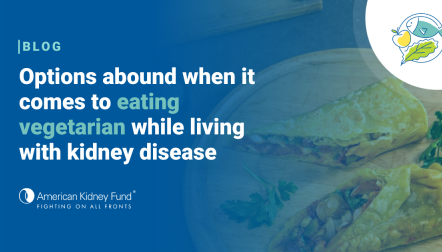
Blog post
Three reasons to make weighing your food a new habit

In the U.S., most people use dry and liquid measuring cups and spoons (volume measurements) to portion their ingredients when they cook. But did you know that most people around the world weigh their ingredients? By using a kitchen scale, you can measure your ingredients by weight (grams or ounces), which is a much more accurate method of measurement — and a gamechanger if you follow a kidney-friendly meal plan!
Weighing your ingredients will help ensure that the recipes you make support your health. Here are three reasons to buy a kitchen scale and start weighing your ingredients today:
1. Weighing food is more accurate than measuring by volume
No matter how experienced you are in the kitchen, the cup of ingredients you weigh today will not weigh the same tomorrow. Why? Because volume measurements are less accurate.
Volume is a measurement of how much space an item fills, and that depends on the size of the item. In the case of food, the size of your ingredients can vary greatly from piece to piece. Just think of the last time you went grocery shopping for a "small" tomato. What exactly is a "small" tomato? Vegetable sizes can differ depending on the season, your supermarket, the variety and your own judgement or hand size.
Weight, on the other hand will always be the same — no matter what. One hundred grams of an ingredient will always be 100 grams. Just remember to follow the recipe's instructions when you weigh your food. The weight of an ingredient can change depending on how it is used in the recipe — with or without skin, stems or bones; before or after it is diced or grated; and when it is raw versus after it is cooked.
2. Weighing food gives you better control of your nutrient intake
Measuring your fruits, vegetables and meats by volume may cause you to consume more of the nutrients you need to monitor, like potassium, posphorus, sodium and protein.
Using tomatoes as an example again, there are 252 mg of potassium and 26.9 mg of phosphorus in 100 grams of tomatoes. If you use a cup to measure your tomatoes and end up with 25 grams more than the recipe calls for, that might not seem like a big difference. But even just 25 grams of extra tomatoes adds 63 mg of potassium and 6.7 mg of phosphorus to the recipe. If you are following a Kidney Kitchen® recipe, this means your nutrient values won't match the nutrition information we have calculated for each recipe that help you follow the kidney-friendly meal plan recommended by your doctor and dietitian.
Using a scale to weigh your ingredients makes the measurements more accurate and helps you better control your nutrient intake. And, bonus – the recipe will likely turn out better. This will also allow you to eat a greater variety of foods, including small amounts of foods higher in certain nutrients, without worrying about going over your recommended levels.
3. Weighing ingredients is a faster, easier and cleaner way to cook
Our recipes in Kidney Kitchen use a variety of vegetables. Preparing different amounts of all ingredients and using multiple measuring tools to do so likely means you're dirtying a lot of dishes in the process. The beauty of weighing your vegetables is that you don't need several measuring cups or spoons to make sure you have the right amount of each ingredient in a recipe. You just need one tool: a kitchen scale. The kidney-friendly ingredient amounts in Kidney Kitchen recipes have all been carefully weighed when creating them, so you can recreate them yourself with confidence.
You'll be surprised by how fast and easy it is to weigh one ingredient after the other by simply using your scale's tare function in between each one. To use the tare function, place a bowl on the scale and then press the "tare" button, which removes the bowl's weight from the total. You then add your ingredients one by one to the bowl, pressing tare in between each. With your handy scale, you can more quickly measure out all the ingredients in the filling for our Columbia Fish Tamale recipe, and only get one item dirty in the process — your bowl, which you need for containing ingredients while preparing the dish anyway!
Tip: It is easier to add more of an ingredient than to take out extra from the bowl, especially if you are measuring all ingredients in the same bowl. To avoid accidental overages of ingredients that are not easy to remove, you can also measure all your ingredients individually in a smaller bowl, then move them one by one to a larger mixing bowl once you get the right weight. Cleaning two bowls is still easier than cleaning a bunch of measuring cups and spoons.
How to choose the perfect kitchen scale
Now that you know a kitchen scale is your new best friend, how do you know which one to buy? There are many different kitchen scales on the market in all different price ranges, so here are some tips for choosing the right one for you:
- Make sure it has a tare button
- Make sure it is capable of measuring small amounts, like ⅛ ounce or 1 gram, so you know you are accurately controlling your nutrient intake
- Look for a scale that is easy to use
- Look for a scale with a digital display that is easy to read, with large numbers and backlights
- Look for a scale that is thin and cordless
- Look for a stainless steel or hard plastic scale, so it is easy to clean
- Look for a scale that is 9x6 inches or smaller, so it is easy to store away when you are not using it
Kitchen scale prices can vary, but they are generally within reach for most budgets. One you add this very useful appliance to your kitchen, you'll prepare more delicious recipes with the confidence that you are eating the exact amount of nutrients that our Kidney Kitchen recipes call for. Happy cooking!





